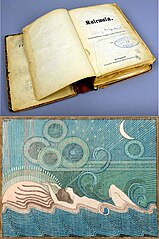| Luonnotar | |
|---|---|
| Tone poem by Jean Sibelius | |
 The composer (c. 1911) The composer (c. 1911) | |
| Opus | 70 |
| Text | Kalevala (Runo I) |
| Language | Finnish |
| Composed | 1913 (1913) |
| Publisher | Breitkopf & Härtel (1981) |
| Duration | 10 mins. |
| Premiere | |
| Date | 10 September 1913 (1913-09-10) |
| Location | Gloucester, England |
| Conductor | Herbert Brewer |
| Performers | |
Luonnotar (Finnish pronunciation: [ˈluo̯nːotɑr]), Op. 70, is a single-movement tone poem for soprano and orchestra written in 1913 by the Finnish composer Jean Sibelius. The piece is a setting of Runo I (lines 111–242, freely adapted) of the Kalevala, Finland's national epic, which tells the legend of how the goddess Luonnotar (the female spirit of nature) created the Earth. Luonnotar premiered on 10 September 1913 at the Three Choirs Festival in Gloucester, England, with Herbert Brewer conducting the festival orchestra; the soloist was the Finnish operatic diva (and frequent Sibelius collaborator) Aino Ackté, the tone poem's dedicatee. A few months later on 12 January 1914, Ackté gave Luonnotar its Finnish premiere, with Georg Schnéevoigt conducting the Helsinki Philharmonic Orchestra.
History
 The metre and myths the Kalevala inspired many of Sibelius's tone poems, including 1913's Luonnotar.
The metre and myths the Kalevala inspired many of Sibelius's tone poems, including 1913's Luonnotar. The celebrated Finnish operatic soprano Aino Ackté (here in 1910 as Salome) commissioned Luonnotar from Sibelius.
The celebrated Finnish operatic soprano Aino Ackté (here in 1910 as Salome) commissioned Luonnotar from Sibelius.
 A goddess of creation (here painted by Akseli Gallen-Kallela) is a storytelling devise common to many mythologies and religions.
A goddess of creation (here painted by Akseli Gallen-Kallela) is a storytelling devise common to many mythologies and religions. Gloucester Cathedral, at which Ackté premiered Sibelius's Luonnotar on 10 September 1913.
Gloucester Cathedral, at which Ackté premiered Sibelius's Luonnotar on 10 September 1913.

Luonnotar is thematically unrelated to an earlier project of Sibelius's by the same name from 1903–1905; that 'Luonnotar' (for which a fragment is extant) grew out of the abandoned oratorio Marjatta (without catalogue number) and, by 1906, had evolved into the orchestral tone poem Pohjola's Daughter (Pohjolan tytär, Op. 49). In 1913, Sibelius arranged Luonnotar for soprano and piano.
Instrumentation
Luonnotar is scored for the following instruments and voices, organized by family (vocalists, woodwinds, brass, percussion, and strings):
- Soprano
- 2 flutes (each doubling on piccolo), 2 oboes, 2 clarinets (in A), 1 bass clarinet (in B♭), and 2 bassoons
- 4 horns (in F), 2 trumpets (in B♭), and 3 trombones
- Timpani (2 players)
- Violins (I and II), violas, cellos, double basses, and 2 harps
Music
Discography
The Hungarian-American conductor Antal Doráti and the London Symphony Orchestra made the world premiere studio recording of Luonnotar in February 1969 for His Master's Voice (HMV); the soloist was the Welsh soprano Dame Gwyneth Jones. However, recordings of two earlier live performances by the Helsinki Philharmonic Orchestra also are commercially available: first, led by the Finnish conductor Georg Schnéevoigt in 1934, with the Finnish soprano Helmi Liukkonen [fi] as soloist; and second, led by the Finnish conductor Tauno Hannikainen in 1955, with the Austro-British soprano Dame Elisabeth Schwarzkopf as soloist. The table below lists these and other recordings:
Additionally, in 2008, BIS made the world premiere studio recording of Sibelius's transcription of Luonnotar, with the Finnish soprano Helena Juntunen and the Finnish pianist Folke Gräsbeck [fi]. The table below contains additional details about this recording:
| No. | Soloist | Pianist | Rec. | Time | Recording venue | Label | Ref. |
|---|---|---|---|---|---|---|---|
| 1 | Helena Juntunen (2) | Folke Gräsbeck [fi] | 2008 | 8:48 | Kuusankoski Concert Hall [fi] | BIS |
Notes, references, and sources
- Notes
- Although Breitkopf & Härtel did not publish the first edition of the orchestral version of Luonnotar until 1981, the reduction for soprano and piano first appeared in 1915.
- The second flutist only plays two notes on piccolo.
- ^ Refers to the year in which the performers recorded the work; this may not be the same as the year in which the recording was first released to the general public.
- G. Schnéevoigt—Warner Classics (2564 605317) 2015
- T. Hannikainen—Gala (GL100.820) 2013
- A. Dorati—EMI Classics (7243 5 85785 2 2) 2004
- L. Bernstein—Sony Classical (SMK 61848) 2015
- P. Berglund—EMI Classics (7243 5 69773 2 7) 1997
- A. Gibson—Chandos (CHAN 241 19) 2004
- V. Ashkenazy—Decca (473 590–2) 2003
- J. Panula—BIS (CD–270) 1984
- G. Staern—Sterling (CDA 1804/05–2) 2017
- V. Sinaisky—Brilliant Classics (BC 9212) 2010
- N. Järvi—DG (447 760–2) 1996
- P. Järvi—Erato (5220552) 2008
- S. Oramo—Warner Classics (8573 80243–2) 2004
- C. Davis—Profil (PH05049) 2005
- O. Vänskä—BIS (CD–1565) 2006
- L. Segerstam—Ondine (ODE 1080–5) 2006
- U. Schirmer—cpo (777 262–2) 2008
- S. Oramo—BIS (SACD–1962) 2012
- E. Gardner—Chandos (CHSA 5217) 2021
- F. Gräsbeck—BIS (CD–1918/20) 2008
- References
- ^ Dahlström 2003, p. 307.
- ^ Dahlström 2003, p. 306.
- Barnett 2007, pp. 172–173, 176–177, 232–233.
- Tawaststjerna 2008, pp. 37, 51–52.
- Sources
- Barnett, Andrew (2007). Sibelius. New Haven: Yale University Press. ISBN 978-0-300-11159-0.
- Dahlström, Fabian (2003). Jean Sibelius: Thematisch-bibliographisches Verzeichnis seiner Werke [Jean Sibelius: A Thematic Bibliographic Index of His Works] (in German). Wiesbaden: Breitkopf & Härtel. ISBN 3-7651-0333-0.
- Goss, Glenda Dawn (2009). Sibelius: A Composer's Life and the Awakening of Finland. Chicago: University of Chicago Press. ISBN 978-0-226-00547-8.
- Magoun, Jr., Francis Peabody, ed. (1963). The Kalevala: Or Poems of the Kaleva District. Cambridge, Massachusetts: Harvard University Press. ISBN 9780674500105.
- Tawaststjerna, Erik (2008) . Sibelius: Volume 2, 1904–1914. Translated by Layton, Robert. London: Faber and Faber. ISBN 978-0-571-24773-8.
External links
- Luonnotar, Op. 70: Scores at the International Music Score Library Project
Categories: